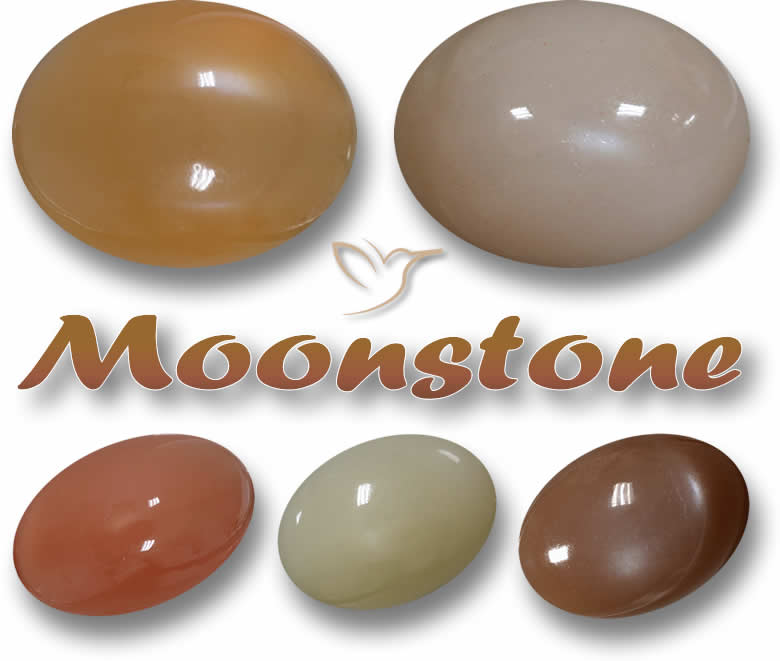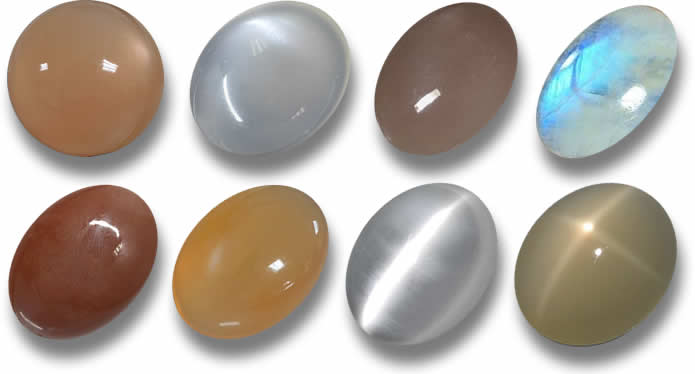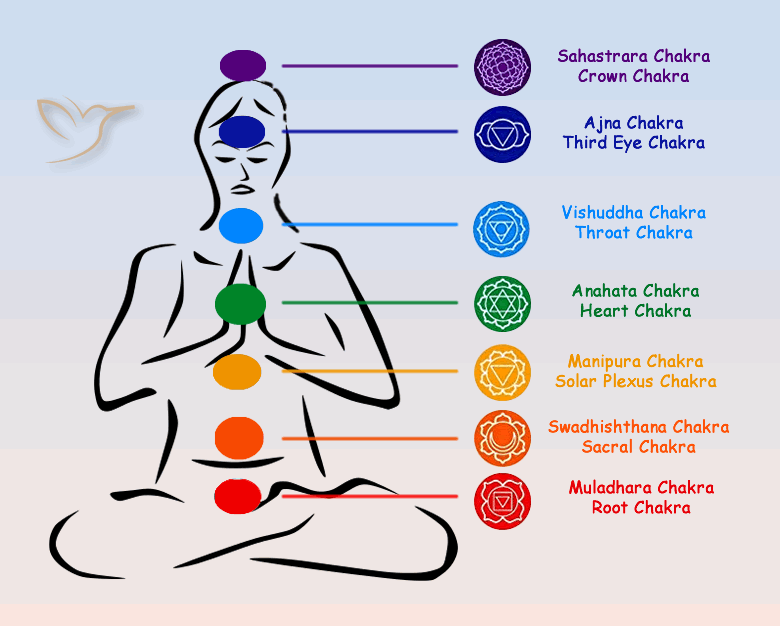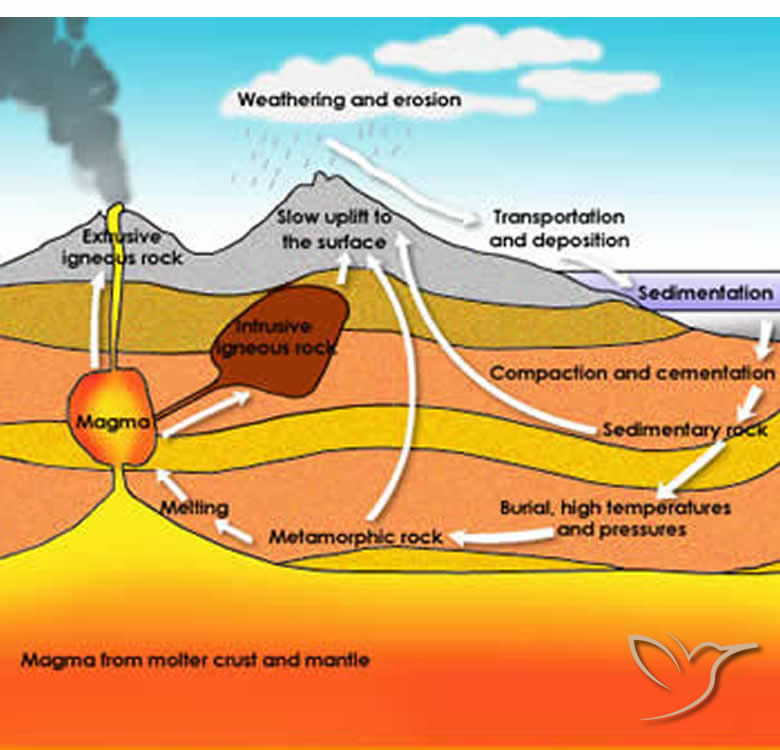Moonstone Gemstone Information

Introduction
Let's set aside the technical details for a bit and imagine viewing a Moonstone as an Ancient Egyptian, Greek, or Roman might have. That inner glow, the flash of color in the light, the silky surface that almost feels like it's flowing - it's no surprise they believed this gem came straight from the moon's rays.
Terms like the Schiller effect, adularescence, light interference, and lamellar crystal formation explain the gleam in scientific ways. But isn't it more fun to think of them as captured moonbeams infused with happy energies? And honestly, it's a whole lot easier to grasp! Read more about Moonstone gemstones.
Moonstone Colors

Unlike many other gemstones, the value of a Moonstone isn't solely based on its color.
What really sets Moonstones apart is that glowing sheen that appears to hover on the surface. A clear, colorless body showcases this effect perfectly. These gems appear in white, gray, pink, yellow, orange, brown, and red shades, each with its own appeal, but it's the almost fluid gloss or shimmer on the surface that drives the value.
The underlying color comes from mineral impurities that blended with silicon and aluminum during crystal formation. Various chemicals and minerals fused under intense heat from erupting magma, forming molten rock for a time.
Once the volcanic activity cooled down, the rocks hardened, and minerals separated into thin layers. In gem form, light hitting these layers deflects and reflects, creating shimmering colors. Thinner layers are rarer and produce more blue tones. This blue is most common in Rainbow Moonstone, which is technically a Labradorite but often grouped with Moonstones.
Moonstone Species
Moonstones belong to the feldspar group, the most abundant mineral on Earth, combining silica and aluminum to make up over half the planet's crust. While geologists might dive deep into the composition, what matters most is the beauty of thatglowing luster.
Technically, Moonstones are Orthoclase Feldspars - that's a mouthful for a jewelry shop - and "Moonstone" is simply the trade name for those showing the shimmer called adularescence.
Rainbow Moonstone is a Labradorite variant with a similar iridescent quality, so it's often treated as the same. Labradorite, Sunstone, and Amazonite share close chemical makeups and are also feldspars. More details on Rainbow Moonstone characteristics.

A rare yet sought-after type is Cat's Eye or Star Moonstone, where inclusions reflect a thin light band like a cat's eye or, less often, a star with four, six, or more rays. This effect paired with the moon-like glow makes for an intriguing gem. Discover Cat's Eye Moonstone specifics. Explore Star Moonstone properties.

Moonstone Clarity and Cut

Gemstones generally fit into three clarity categories, with variations: Opaque ones block all light, translucent allow some through but not clearly, and transparent let light pass freely, so you can see or read through them.
Moonstones range from translucent to transparent, and greater transparency boosts value. Inclusions can disrupt adularescence, so fewer are better. A typical inclusion resembles a centipede.
Moonstones are almost always shaped into oval or round cabochons to highlight the shimmer. The effect is often stronger in one direction, so cutters must study the stone to decide the best orientation for cutting and polishing.
What is the spiritual meaning of Moonstone?
Disclaimer: The details on spiritual and healing aspects of Moonstone draw from traditional beliefs and folklore. They are shared for informational purposes and should not replace advice from qualified medical professionals.
Given its otherworldly appearance, it's understandable why Moonstone is steeped in myths and spiritual associations. Across ancient cultures from east to west, people thought these gems fell from the sky, and that magical shimmer does suggest something beyond the ordinary.
Linked closely to the moon, Moonstone is often viewed as embodying feminine energies like intuition, creativity, nurturing, and pure love.
Different minerals in each stone influence its spiritual traits, and varieties like Star, Cat's Eye, or Rainbow Moonstone (actually Labradorite) add layers to this.
A straightforward way to gauge a Moonstone's spiritual vibe is by its color. White ones represent the moon at full strength, enhancing insight and vision.
Orange Moonstone promotes balance, eases stress, and attracts good fortune. Yellow aids in vivid dreams and restful sleep. Blue can mend emotional wounds and open doors to new relationships.
As you might notice, they share soothing qualities that help with emotional challenges.
Known for aiding change, Rainbow Moonstone supports life transitions, whether planned or unexpected. It's great for work settings, fostering communication, collaboration, and dedication. Overall, it brings a positive spark to daily routines.
Cat's Eye and Star Moonstones top the list, said to amplify standard Moonstone traits - like sharpening focus and prioritizing what's key in life.
Moonstone and the Chakras

The body has seven energy points called Chakras - from the Sanskrit for "wheel" or "circle." Each affects specific physical, emotional, or mental states and ties to a color. They align from the spine's base up to the head's crown: Root (red), Sacral (orange), Solar Plexus (yellow), Heart (green), Throat (blue), Third Eye (indigo), and Crown (purple).
Sometimes Chakras get off-balance or blocked and need realignment. Gemstones, often in matching colors, can help, though many contain minerals influencing multiple points.
With varied colors and compositions, Moonstones connect to several Chakras but traditionally link to the Third Eye, Crown, and even the Soul Star for clairvoyance and intuition.
Signs of a blocked Third Eye include poor focus, quick temper, or future worries. A Crown imbalance might show as lost motivation for once-enjoyable activities.
If these sound familiar, a Moonstone might offer support. Uncover Moonstone lore and traditions.
Health Benefits of Moonstone
Disclaimer: The details on spiritual and healing aspects of Moonstone draw from traditional beliefs and folklore. They are shared for informational purposes and should not replace advice from qualified medical professionals.
We sometimes get questions on using gemstones for spiritual or health perks, and while we're not experts, we've gathered some insights over time.
Wearing it in jewelry near the relevant Chakra is a simple approach.
Or carry one in your pocket as a quick comfort touchstone. For meditation, hold it in your hand, or relax with it placed on a Chakra.
Tied to feminine energy, Moonstone is noted for impacts on women's health, like balancing hormones, supporting reproduction, easing PMS or childbirth pain, and aiding fertility, pregnancy, breastfeeding, and menopause.
For all, it may counter degeneration in skin, hair, and eyes; bolster circulation and immunity; reduce fluid retention; cleanse blood; and promote healthy stomach, pancreas, and liver function.
Cleanse Moonstone biweekly by rinsing in tepid water - ideally natural like spring or rain - and sun-drying for an hour.
For extra recharge, leave it under a full moon overnight.
Moonstone Price

Moonstone Price List |
||
|
Type |
Weight range |
Price range / USD |
|---|---|---|
|
Moonstone |
all weights |
$1.30 - 15/ct |
|
Cat's Eye Moonstone |
all weights |
$3 - 50/ct |
|
Rainbow Moonstone |
all weights |
$5 - 60/ct |
|
Star Moonstone |
all weights |
$2 - 30/ct |
Colored gem values hinge on color, clarity (for non-opaques), size, and cut.
For Moonstones, the shimmer - or adularescence - is key. Once that's confirmed, color follows.
They vary in hues, but intense blue floating over the surface is most prized and valuable. White, evoking the actual moon, comes next.
Yellow, orange, brown, red, and gray depend on preference, provided the shine is present and color uniform.
Clarity rivals color; ideal Moonstones have silky surfaces, vivid blue glows, and transparency to highlight them. Flaws can mar the gloss, regardless of color.
Most are cabochons for the satin finish, often high-domed to enhance adularescence.
Size matters last: with equal quality, larger is pricier. Clear ones typically range 1-5 carats, up to 20 rarely. Check Moonstone gems for sale.
Moonstone Discovery and History

Moonstones have adorned people for millennia, linked to ancient Greek and Roman goddesses like Diana, Selene, and Artemis. Its ancient Greek name blended Aphrodite and Selene as 'Aphroselene'.
In India, it was sacred, shown only on yellow cloth, born from a clash between Lord Vishnu and demon Bali. In Sanskrit, it was Chandrakanta, 'beloved of the moon'.
Sri Lanka, off India's south, was the classic source.
Switzerland's Mt. Adular yielded fine ones recently, inspiring 'Adularia' for Swiss Moonstones and 'adularescence' for their sheen.
Did you know? Interesting facts about Moonstones
- It is the size of a chicken's egg!
- The largest known Moonstone was discovered on Mt Kilimanjaro in Tanzania by Japanese climbers in 1918 and is estimated to be nearly 450 carats.
- Moonstone is the birthstone for the month of June, alongside the Pearl.
- Florida's State Gemstone
- The rockets that took men to the moon took off from the Kennedy Space Center in Florida. Not long after the first moon landings, Moonstones became the state gemstone even though they are not found there.
- Moonstones are the gemstones for the Zodiac sign of Cancer.
- Fertility Symbol
- In Arabic countries, women wishing to have babies will sew Moonstones into the lining of their dresses to increase fertility.
- Moonstone amulets were hung from fruit trees or buried in the soil to increase crops.
- Look out billow!
- A popular word gemstone dealers use to describe the almost liquid-like sheen that is possessed by the best Moonstones is 'billowing'.
- Moonstones were said to help men turn into werewolves at the full moon.
Where is Moonstone found?

Moonstones still come from ancient Sri Lanka and nearby India, a big Rainbow Moonstone supplier. Other sources include Australia, Brazil, Myanmar, Madagascar, Mexico, Europe, and the US.
Stunning blue ones emerge from Sri Lanka's southwest mountains. Local rules and customs protect the environment there.
Mining uses minimal machinery, done by hand with coconut planks for support. Material rises via rope and bucket, gets washed and sorted on astrologically favorable days, then polished into cabochons.
How is Moonstone formed?

As a feldspar, Moonstone occurs worldwide in igneous, metamorphic, and sedimentary rocks. Feldspar forms via magma crystallization, heat/pressure underground, or sedimentary compression.
For Moonstone, volcanic heat/pressure melts minerals that mix. Cooling separates them if slow. Orthoclase and Albite are essential.
They solidify at different rates; slow cooling creates thin layers. In gems, these cause the pearly luster.
Light through layers traps, scatters, or reflects for the Schiller or adularescent effect.
This needs specific minerals and prolonged cooling; otherwise, similar rocks lack the shimmer.
Can Moonstone be treated?
Beyond standard cutting and polishing to shape an attractive gem, Moonstones aren't enhanced or treated, to our knowledge.
If any GemSelect stones receive treatments, we always note it.
What Jewelry is Moonstone suitable for?
At 6–6.5 on Mohs, it's durable for most jewelry but needs care in rings or bracelets prone to impacts, unlike earrings or pendants.
Moonstone shone in 1900s Art Nouveau by Rene Lalique, then in 1960s Bohemian styles.
Today, it's popular with crafters for unique, budget-friendly pieces.
How to care for Moonstone
Store in fabric-lined boxes or soft cloth. At 6–6.5 Mohs, separate from harder/softer gems to avoid scratches.
Clean with warm soapy water, soft brush, rinse, and dry softly - no ultrasonics or steam. Remove before activities like sports or chores.
How can you tell a real Moonstone?

Buy from trusted sellers, but when hunting deals, know what to check.
Moonstones stand out by their silky surface glow. Study real ones first - easy for white or blue-tinted with obvious adularescence, trickier for colored.
Watch for fluid-like sheen. Colored Chalcedonies mimic red/orange/green/brown Moonstones, but lack pearl iridescence.
Hardness tests aren't helpful here, as similar materials score close.
Beware glass fakes (Opalite) - too perfect, possibly bubbly. Real ones show layers or inclusions.
suspiciously low prices signal fakes.
This isn't exhaustive, but helpful.
At GemSelect, we guarantee descriptions, disclose treatments, and offer returns for confidence.
Can Moonstone change color?

Some gems shift colors under lights - like Alexandrite green indoors, red in sun.
This rare trait occurs in Alexandrite, Garnet, some Sapphires. Moonstones have remarkable glows but aren't color-changers.
What is so special about Moonstone?
Rough Moonstone from a mine looks ordinary. A river-worn pebble, shaped over ages by water and sand, seems nicer.
But a well-cut, transparent Moonstone with floating blue aura over pearly surface? Even with science background, it feels magical.
Moonstone - Gemological Properties
|
Chemical Formula: |
KalSi3O8, Potassium aluminum silicate |
|
Crystal Structure: |
Monoclinic, prismatic |
|
Color: |
Colorless, yellow, brown, orange, pale sheen |
|
Hardness: |
6 to 6.5 on the Mohs scale |
|
Refractive Index: |
1.518 to 1.526 |
|
Density: |
2.56 to 2.59 |
|
Cleavage: |
Perfect |
|
Transparency: |
Transparent to translucent |
|
Double Refraction or Birefringence: |
-0.008 |
|
Luster: |
Vitreous to pearly |
|
Fluorescence: |
Weak; bluish, orange |
Frequently Asked Questions
What colors are available in Moonstones?
Moonstones appear in white, gray, pink, yellow, orange, brown, and red, with value often tied to the intensity of their shimmering sheen rather than just the hue.
What is adularescence in Moonstones?
Adularescence is the glowing, floating sheen on Moonstones caused by light reflecting off internal layers, giving them their signature moon-like appearance.
Is Moonstone suitable for everyday jewelry?
Yes, but with care - its 6-6.5 Mohs hardness makes it fine for pendants or earrings, though rings and bracelets might need protection from knocks.
How do I clean my Moonstone?
Use warm soapy water and a soft brush, rinse well, and dry with a soft cloth. Avoid ultrasonics, steam, or harsh chemicals.
Where do the best Moonstones come from?
Sri Lanka and India are top sources, especially for blue-hued and Rainbow varieties, with mining practices that respect the environment.

